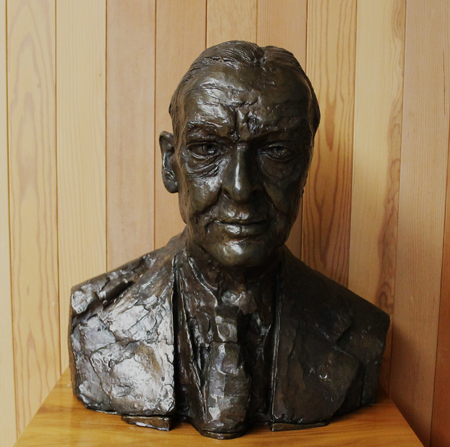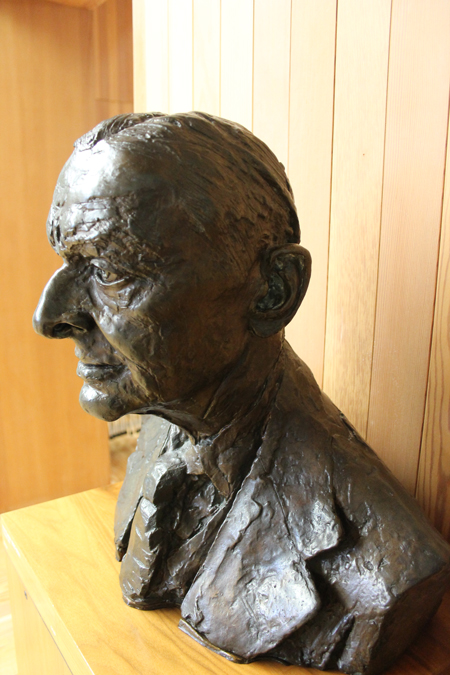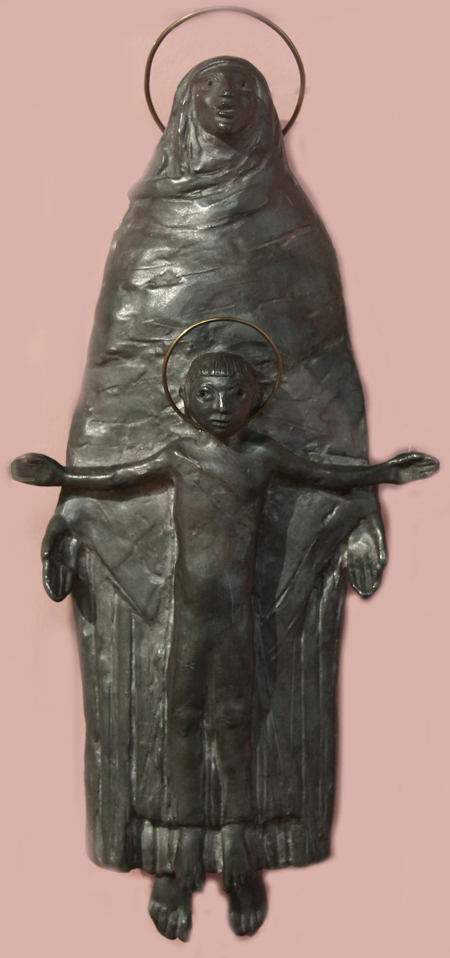Object in Focus: The ‘Agèd Eagle’ - Jacob Epstein, T.S. Eliot (1952)
Matthew Geary discusses Jacob Epstein's bronze bust of T.S. Eliot, one of the most celebrated poets of the twentieth century. Drawing on little-known materials and correspondence, Geary details Eliot's sitting for Epstein in 1951, and from this he charts the development of a heartfelt and unlikely friendship in the latter years of both men's lives.
Download a PDF of this article
Keywords: Jacob Epstein, Sculpture, Modernism, Twentieth-Century Art, T.S. Eliot.

Fig.1 Sir Jacob Epstein, T.S. Eliot (1952), bronze, 48.3 cm ©The New Art Gallery Walsall, photo ©April-Lina Waine
Sir Jacob Epstein (1880-1959) was famed in his lifetime for his portrait bronzes. A tremendous bust of T.S. Eliot (1952, fig.1), Anglo-American poet, critic and publisher (1888-1965), is in the Garman-Ryan Collection at The New Art Gallery, Walsall. Kathleen Epstein (née Garman) (1901-79), Jacob's second wife and widow, formed the collection (1959-73) with close friend and sculptor Sally Ryan (1916-68), following her husband's death. Kathleen was born in Wednesbury, a market town in the Black Country, and wanted to give something back to the region where she had grown up. She gifted the bust as part of the collection to Walsall Borough in 1973. One of the most celebrated poets of the twentieth century, T.S. Eliot won the Nobel Prize and the Order of Merit in 1948. He is one of many contemporary luminaries that Epstein sculpted: others include Winston Churchill, Albert Einstein, Somerset Maugham, Paul Robeson, Bertrand Russell, George Bernard Shaw, Rabindranath Tagore, and Vaughan Williams.
Critics have not written at length about the relationship between Eliot and Epstein, and the circumstances precipitating the commission of the bust are sketchy [1]. This is perhaps not surprising as Eliot and Epstein are not immediately recognisable as bedfellows. Moreover, contentious critical debates over claims of Eliot's anti-Semitism have eclipsed constructive discussions about his friendships with prominent Jewish artists and intellectuals, such as Epstein and Horace M. Kallen [2]. This article draws on Eliot and Epstein archival material and correspondence, much of it neglected or unknown, to document Eliot's sitting for Epstein in 1951 and the creation of the bust in greater detail than previously. The new materials and information emphasise the strength, development and deeply personal nature of the Eliot-Epstein friendship through the 1950s to Epstein's death, and the influence of this relationship on each man's latter life and works. I see this as the first step for a much more comprehensive reading and rethinking of their connection; especially regarding modernist elaboration of secular/secular-divine/religious maternal form and poetics.
During his lifetime, Eliot was known as esoteric, remote and reserved, 'Old Possum' as Ezra Pound liked to call him. Likewise, his poetry continuously assumes various masks and personae: from the 'diffident' Prufrock, to 'old man' Gerontion, and 'Apeneck' Sweeney. These masks regulate a certain impersonality and distance from the poet. Yet, Epstein's sculpture has the remarkable quality of unveiling him. In Eliot's 'The Love Song of J. Alfred Prufrock' (1915), first published when he was twenty-six, Prufrock foresees himself in later life: 'my head (grown slightly bald) brought in upon a platter' [3]. In 'Ash-Wednesday' (1930), Eliot refers to himself as the 'agèd eagle', alluding to his strong-set aquiline features (the bird appears seven times in Eliot's works), as well as apprehending the significance of his old age [4]. A few years later, he envisages in 'Difficulties of a Statesman' (1931-32): 'Here is the row of family portraits, dingy busts, all looking remarkably Roman, /Remarkably like each other' [5]. Eliot would come to see all these visions amalgamated and brought to fruition in Epstein's wonderful bronze, completed in 1951, when Eliot was in his later years.

Fig.2 Sir Jacob Epstein, T.S. Eliot (1952), bronze, 48.3 cm ©The New Art Gallery Walsall, photo ©April-Lina Waine
As Richard Buckle notes, Epstein's bust of Eliot has 'the air of a benevolent bird of prey' [6]. Modelled in Epstein's late 'smooth' style, the face is bony, stoic and pensive (fig.2) [7]. The torso is leant forward suggesting a bent, aging spine. The profile is Roman with a prominent nose and the nasal tip enlarged and slightly hooked. The eyes are deep set and heavy-lidded, but courteous and attentive to the sculptor. Epstein has truthfully rendered the face with strong nasolabial folds and furrows in the forehead. The muscles of the face are weak, lax and dropped, creating distinct cavitary depressions. And Eliot's hair is tidily swept back but thinning. Epstein's bust reflects the intense toil and seriousness that is lived by any illustrious poet, critic and person of letters. But it also captures an underlying glee and satisfaction, and an often-overlooked mischievous, childlike side to Eliot, revealed in his Old Possum's Book of Practical Cats (1939), which Andrew Lloyd Webber adapted for his famous musical Cats. These aspects of Eliot's personality are relayed by micro-expressions such as a discrete pulling back and up of the corner of Eliot's thinning lips, and a sparkle in the eyes accentuated by crow's feet and lines beneath. Eliot reported that his late years were the happiest of his life since childhood. He would mainly credit this to his second marriage to Valerie Fletcher. More than any other portrait, Epstein's naturalistic bust captures the human essence of Eliot.
Despite both being American by birth and naturalised British citizens (Epstein in 1910; Eliot in 1927), the two men grew up in very different circumstances. Epstein was born on 10 November 1880 in the Jewish ghetto on the Lower East Side of New York, a milieu completely antithetical to Eliot's more comfortable upbringing. Eliot was born into a historically distinguished family on 26 September 1888 in St. Louis, Missouri. His grandfather was the eminent Reverend William Greenleaf Eliot, who co-founded Washington University and the first Unitarian church in St. Louis. Other far-flung family connections included writers Nathaniel Hawthorne, Herman Melville and Henry Adams. Epstein was a secular Jew, a political radical and a wild bohemian, whilst Eliot's attitudes were more conservative, royalist, traditional, and he devoted himself to the Anglo-Catholic faith in his midlife [8]. Although both men were controversial, Epstein was much more ridiculed in his lifetime with critics describing work, such as the sculptures for the front of the British Medical Association Building (completed in 1908), as offensive, inartistic, irreligious and barbaric. Henry Moore's obituary of the sculptor remarks how Epstein 'took the brickbats for modern art, he took the insults, he took the howls of derision', thus forging the way for future artists and innovations [9].
Notwithstanding Epstein's and Eliot's differences, however, the two men produced several of the foundational, landmark works of Modernism — Epstein with his experimental Rock Drill sculpture (1913-15), and Eliot with 'Prufrock' (1915) and The Waste Land (1922). And there are other affinities. In early adulthood, both spent time in Paris where they found artistic and intellectual stimulation (Epstein 1902-5 and Eliot 1910-11). Both moved to England and mixed in similar cliques amongst the British intelligentsia and the international avant-garde. Both were friends of, and championed by, modernist poet and cultural impresario Ezra Pound and painter-author Wyndham Lewis; Eliot and Epstein may have crossed paths through Lewis, but this has never been confirmed [10]. Both contributed to Blast (1914-15), the short-lived but powerfully influential modernist magazine. John Quinn, a wealthy New York Irishman and corporate lawyer, and a significant patron of literature and the arts in the twentieth century, supported both early on in their careers. Both were advocates of modernist poet and essayist T.E. Hulme: Eliot greatly admired Hulme's Speculations (1924), to which Epstein provided a personal Foreword (Epstein was a close friend of Hulme's) [11]. In addition, the works of the two men portray similar fascinations with primitivism and the savage, religion, myth and ritual, the maternal and the feminine, sex and the erotic. Epstein possessed one of the best collections of what was considered 'primitive' and 'exotic' sculpture in Britain, some of which is on display at Walsall.
Eliot and Epstein were great enthusiasts of each other's work. Epstein confessed that he had 'long wanted to carry out' a portrait of Eliot [12]. He had the opportunity to do so in 1951 when poet and playwright Ashley Dukes brought Eliot to his studio. Dukes was ‘a mutual friend’ who put on Eliot’s first play, Murder in the Cathedral (1935), and who commissioned the bust. Epstein recalls Eliot sitting for him: 'I was very impressed by the grave courtesy of his bearing frequently lighted up by a smile at once genial and ironic'. He notes how Eliot 'seemed most interested in the development of the work'. On one occasion, Eliot accompanied Epstein to the foundry where his Madonna and Child, a 411.48 cm sculpture to be placed in Cavendish Square, was being cast in lead (the maquette for Madonna and Child is also at The New Art Gallery, Walsall) (fig.3) [13]. Eliot was 'profoundly impressed'. His own work had become increasingly religious in content, focus, form, and symbolism concomitant with his acceptance into the Anglo-Catholic faith in 1927 (the Virgin Mary appears in 'Ash-Wednesday' and there is the explicit prayer to Mary in 'The Dry Salvages' section of Four Quartets). Epstein looked back on these sittings with 'great pleasure', with the result being a deeply intimate portrait of great psychological profundity [14]. He modelled the bust in clay before making several plaster moulds from which the final bronzes were cast. An edition of nine to ten bronzes are thought to be in existence [15].

Fig.3 Sir Jacob Epstein, Maquette for Cavendish Square Madonna and Child (1950), lead, 35 cm x 15cm x 7 cm ©The New Art Gallery Walsall, photo ©April-Lina Waine
From the sittings, Epstein and Eliot developed a great friendship and growing affection for each other, as shown in correspondence and materials held in archives at Houghton Library, Harvard, the Henry Moore Institute, Leeds, and The New Art Gallery, Walsall. In September 1953, Epstein and Kathleen attended the first performance of Eliot's play The Confidential Clerk at the Lyric Theatre, Hammersmith. A note from Epstein to Eliot on the cover of the programme reads, 'Dear Mr Eliot. We always said you looked like Dante. Now you have written a Divine Comedy' [16]. In 1954, Eliot congratulated Epstein on receiving his '(long overdue) honour' at Buckingham Palace. He closes the letter 'with cordial admiration always' [17]. In 1958, Eliot procured one of the Epstein busts as a birthday present for his second wife, Valerie. Eliot feared Epstein had let him have the bust at 'bargain rates', continuing 'I hope you have not cheated yourself' [18]. In another note, Eliot invited Epstein and his wife to his London flat and trusted his advice ‘as to the best position for the bust [19]. The bronze held pride of place in the Eliot home. For Eliot's seventieth birthday party the same year, Epstein proposed a toast to Eliot's health before a small gathering and had the privilege of cutting the cake (ordered from the Queen's confectioner) [20]. Eliot was delighted. Attendee Fredrick Tomlin reports Epstein 'too seemed as happy as a sandboy, because he too had sailed into quiet waters after a somewhat stormy career' [21].
John Haffenden (editor of Eliot's letters and a friend of Valerie) confirms the Eliots 'felt a huge affection and appreciation for Epstein' [22]. Valerie herself imparted this information. This fact is relayed in a deeply personal and poignant letter written by Eliot and Valerie to Kathleen following her husband's death on 19 August 1959. Eliot writes on hearing the news: 'It is as if some of my world had crumbled away. You have our warmest sympathy. We loved him' [23]. This letter is truly remarkable for it is rare to read Eliot professing his love for someone other than family or spouse.
T.S. Eliot died of emphysema at his home in Kensington, London, on 4 January 1965. According to Judith Hooper and Debbie Whitfield, representatives of the Eliot estate, Valerie considered bequeathing the bust following her husband's death, but ‘could not bear to be parted from the likeness of her beloved Tom' [24]. This comment stands as testament to not only Epstein’s remarkable talents as a sculptor, but also to the depth of personal connection and understanding between these two very great artists and friends. The Eliot bust in Walsall intimates that great scholarly insights may yet be garnered from the Eliot-Epstein connection, a closer inspection of modernist works and the making of unexpected links and comparisons between the visual arts and literature – across its greatest practitioners.
About Matthew Geary
About Matthew Geary
Matthew Geary is a Teaching Fellow in the Department of English at the University of Birmingham. His research is interdisciplinary with specialisms in modernist literature and culture (especially T.S. Eliot, maternal modernism), psychoanalysis, masculinities, feminist philosophy, and critical theory. He welcomes conversations and collaborations in these areas.
Acknowledgements
Acknowledgements
With thanks to Claire Reihill and the Eliot Estate, Julie Brown at The New Art Gallery, Walsall, Errin Hussey at the Henry Moore Institute, Leeds, Adrian Glew at Tate, London, and Susan Halpert at Houghton Library, Harvard. Thanks to Marie Fowler and Kate Nichols for introductions. Also, thanks to John Haffenden, Jim McCue, Alan Munton, Ronald Schuchard and Evelyn Silber for advice on Eliot and Epstein.
Endnotes
Endnotes
[1] Surprisingly, there is hardly any mention of Jacob Epstein in recent edited collection: Frances Dickey and John D. Morgenstern (eds), The Edinburgh Companion to T.S. Eliot and the Arts (Edinburgh, 2016).
[2] On Eliot and anti-Semitism, see: Christopher Ricks, T.S. Eliot and Prejudice (London, 1988), pp.25-76; Anthony Julius, T. S. Eliot, Anti-Semitism and Literary Form (Cambridge, 1995); Ronald Schuchard’s and Marjorie Perloff’s contributions to 'Eliot and Anti-Semitism: The Ongoing Debate', in Modernism/modernity, 10.1 (2003), pp.1-26 and pp.51-70; and John Xiros Cooper, 'Anti-Semitism,' in Jason Harding (ed.), T.S. Eliot in Context (Cambridge, 2011), pp.285-94.
[3] Christopher Ricks and Jim McCue (eds), The Complete Poems of T.S. Eliot (London, 2015), vol.1, p.8.
[4] Ibid., p.87.
[5] Ibid., p.134.
[6] Richard Buckle, Jacob Epstein, Sculptor (London, 1962), p.349.
[7] Ibid., p.347.
[8] In 1928, Eliot declared himself in the preface to For Lancelot Andrewes 'classicist in literature, royalist in politics, and Anglo-Catholic in religion'.
[9] Henry Moore, obituary notice, 'Epstein: An Appreciation', The Sunday Times, (23 August 1959), in Alan Wilkinson (ed.), Henry Moore: Writings and Conversations (Berkeley, 2002), pp.149-50.
[10] It is possible that Eliot and Epstein met each other between 1915 and 1920. Eliot states in a letter to Isabella Gardner dated 4 April 1915: 'I have been having a very interesting time in London – which grows upon me more and more: – there are at least a dozen people whom I like', although he does not name these people. Eliot then lists the radical artists whose work he has seen, including Henri Gaudier-Brzeska, Wyndham Lewis, Jacob Epstein and Edward Wadsworth (whom he names as his favourite). Eliot had attended the second London Group exhibition at Goupil Gallery in March 1915, which featured the work of Lewis, Epstein and Wadsworth. He describes Epstein's 'four things' at the exhibition as 'certainly extraordinarily habile [clever], but did not please me, though once or twice his wood statues (one is painted red) give something suggesting the vigour of a central African image'. Eliot would have seen Epstein's Rock Drill, his Flenite Figures, Cursed Be The Day Wherein I Was Born, and the stylised Mother and Child. The wood statue Eliot mentions is likely Cursed Be The Day Wherein I Was Born (plaster and wood painted red). Whether Eliot attended the opening and met Epstein is not established. See T.S. Eliot letter to Mrs Jack Gardner (4 April 1915), in Valerie Eliot and Hugh Haughton (eds), The Letters of T.S. Eliot (London, 2011), vol.1, pp.100-3.
[11] For Eliot's review of T. E. Hulme's Speculations, see 'Crites'; [T.S. Eliot], 'A Commentary', Criterion 2.7 (April 1924), pp.231-35.
[12] Jacob Epstein, Jacob Epstein: An Autobiography (New York, 1955), p.235.
[13] Epstein produced his first Madonna and Child sculpture in 1926-27, and his Madonna and Child at Cavendish House was highly praised. However, Epstein's religious works have been the subject of heated discussion and often deemed as crude and irreligious. His focus on Christian rather than Jewish figures and iconography has caused particular controversy. See George A. Cevasco, 'Epstein's Religious Art', Irish Quarterly Review, 47.186 (1958), pp.177–84.
[14] Buckle (1962), remarks that 'few of our poets have been portrayed so well', p.349.
[15] There is differing information about how many bronzes were cast. A mimeograph of National Portrait Gallery Acquisitions 1965 (Houghton, Harvard, MS 2560/219), which lists an acquisition of T.S. Eliot portraits (including the original plaster bust), records an edition of ten. In contrast, a representative of the University of Kent, where Valerie Eliot donated one of the busts, states that nine were cast. See Unknown Author, 'T.S. Eliot bust presented to the University of Kent', BBC (2 November 2013), accessed 15 June 2018.
[16] Jacob Epstein, program note to T.S. Eliot, 16 September 1953, Houghton Library, Harvard University, T.S. Eliot Collection, MS Am 2560/384.
[17] T.S. Eliot, letter to Jacob Epstein, 5 April 1954, Henry Moore Institute Archive, Jacob Epstein Collection, 36/1988.
[18] T.S. Eliot, letter to Jacob Epstein, 13 June 1958, Henry Moore Institute Archive, Jacob Epstein Collection, 36/1988.
[19] T.S. Eliot, note to Jacob Epstein, 26 May 1958, The New Art Gallery, Walsall, Beth Lipkin Archive, BL/1/1/1/27.
[20] For report of Eliot's seventieth birthday party, see Frederick Tomlin, T.S. Eliot: A Friendship (Abingdon, 1988), pp.212-14, and Rupert Hart-Davis's diary entry in The Lyttelton Hart'Davis Letters (London, 1981), vol.3, pp. 139-41.
[21] Ibid., p.214.
[22] John Haffenden, email to Matthew Geary, 8 March 2018.
[23] T.S. and Valerie Eliot, letter to Kathleen Epstein, 21 August 1958, Henry Moore Institute Archive, Jacob Epstein Collection, 36/1988.
[24] Unknown Author, 'T.S. Eliot bust presented to the University of Kent' (2013).